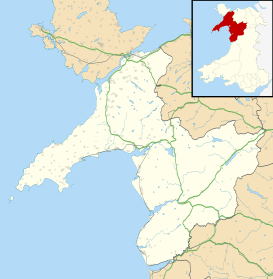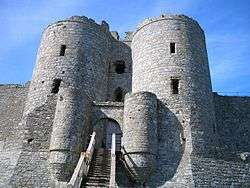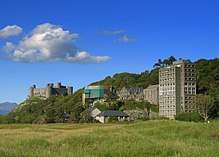Harlech
| Harlech | |
|---|---|
|
Harlech as viewed from the beach area, the Castle is located centre-left | |
 Harlech Harlech shown within Gwynedd | |
| Population | 1,447 (2011 Census) |
| OS grid reference | SH581312 |
| Community |
|
| Principal area | |
| Ceremonial county | |
| Country | Wales |
| Sovereign state | United Kingdom |
| Post town | HARLECH |
| Postcode district | LL46 |
| Dialling code | 01766 |
| Police | North Wales |
| Fire | North Wales |
| Ambulance | Welsh |
| EU Parliament | Wales |
| UK Parliament | |
| Welsh Assembly | |

Harlech (Welsh pronunciation: [ˈharlɛχ]) is a seaside resort and community in Gwynedd within the historic boundaries of Merionethshire in north-west Wales.[1] It lies on Tremadog Bay in the centre of Gwynedd, within the Snowdonia National Park. Of a population of 1,447, 51 per cent habitually speak the Welsh language.[2] Its best-known landmark, Harlech Castle, was begun in 1283 by Edward I of England, captured by Owain Glyndŵr, and later served as a stronghold for Henry Tudor.[3] It was built next to the sea, but coastline changes mean it now lies on a cliff face, about half a mile (800 m) inland.[4] The town has developed housing estates in the low town area and hillside housing in the high town around the shopping street, church, and castle. The two are linked by a steep, winding road called "Twtil".[5]
Etymology
The exact derivation of the name "Harlech" is unclear. Some mostly older sources claim that it derives from Arddlech, i.e. ardd (high) + llech (rock),[6][7] referring to the prominent crag on which the castle stands. More recent sources tend to go for a simpler derivation from the two Welsh words hardd (fair/fine) and llech (slate/rock).[8]
As late as the 19th century some texts referred to "Harddlech" and "Harddlech Castle".[9][10] This name appears in the mid-19th century translation of the Mabinogion: "And one afternoon he was at Harddlech in Ardudwy, at a court of his. And they were seated upon the rock of Harddlech overlooking the sea." Contemporary documents from the time of the Mabinogion do not mention Harlech, referring only to Llywelyn building his castle "at Ardudwy".[11]
Governance
An electoral ward in the same name exists. This stretches to include Talsarnau Community. The population of the ward taken at the 2011 census was 1,997.[12]
Transport
The town's railway station is served by the Cambrian Coast Line. It also contains Ffordd Pen Llech, a street which descends the rock spur to the north of the castle, and has the steepest signed gradient on a public road in the United Kingdom.
Educational facilities
Ysgol Ardudwy is the county secondary school for children between the ages of 11–16. Ysgol Tanycastell is the town's primary school for children between the ages of 3–11. The town was until 2017 also the home of Wales's only long-term adult residential college, Coleg Harlech, also known as the "college of second chance". The premises remain in use as part of Adult Learning Wales - Addysg Oedolion Cymru.
Recreation
Theatr Harlech (formerly Theatr Ardudwy) is located on the Coleg Harlech campus and stages a varied selection of plays, music, and films throughout the year.
Other attractions in Harlech include its beach backed with sand dunes and the famous Royal Saint David's Golf Club, which hosted its fifth British Ladies Amateur in 2009. The Rhinogydd (or Rhinogs) range of mountains rises to the east.
A World War II-era fighter aircraft was found on Harlech beach in 2007. The discovery of the Lockheed P-38 Lightning has been described as "one of the most important WWII finds in recent history". The International Group for Historic Aircraft Recovery (TIGHAR) is not divulging the precise location of the U.S. Army Air Forces plane, known as the Maid of Harlech, but hope eventually to salvage the wreck.[13]
Harlech has a Scout hut which acts as base for outdoor recreational activities.[14]
In traditional and popular culture
- In the second branch of the Mabinogi ("Branwen, Daughter of Llŷr"), Harlech is the seat of Bendigeidfran, Branwen's brother and king of the Isle of the Mighty.[15]
- The song Men of Harlech is traditionally said to describe events during the seven-year siege of the castle in 1461–68.[16]
- Mari Strachan's 2009 novel The Earth Hums in B Flat is set in Harlech in the 1950s.[17]
- ITV Wales & West (formerly known as HTV/Harlech Television)
Famous residents
In birth order:[18]
- Owain Glyndŵr (c. 1359 – c. 1415), Welsh Rebellion leader and the last Welshman to claim the title Prince of Wales
- Ellis Wynne (1671–1734), Welsh-language author
- Alfred Perceval Graves (1846–1931), poet, bard and songwriter. He and a large family, including his son the poet Robert Graves, spent summers at a large house, "Erinfa", north-east of Harlech.[19]
- George Davison (1854–1930), photographer
- Margaret More (1903–1966), composer, was born here.
- Elinor Lyon (1921–2008), children's writer. She retired here in 1975 with her schoolteacher husband.[20]
- David Gwilym Morris Roberts (born 1924), civil engineer, was born here.
Gallery
 Harlech Castle with flags at half mast after death of Queen Elizabeth the Queen Mother in 2002
Harlech Castle with flags at half mast after death of Queen Elizabeth the Queen Mother in 2002 Harlech Castle gatehouse
Harlech Castle gatehouse The Two Kings (sculptor Ivor Robert-Jones, 1984) near Harlech Castle, Wales. Bendigeidfran carries the body of his nephew Gwern
The Two Kings (sculptor Ivor Robert-Jones, 1984) near Harlech Castle, Wales. Bendigeidfran carries the body of his nephew Gwern Harlech Beach at low tide.
Harlech Beach at low tide. Harlech College with Harlech Castle in background
Harlech College with Harlech Castle in background
See also
- Morfa Harlech sand dunes
- Harlech Castle
- St. David's Hotel
- Lord Harlech
- HTV - Harlech Television
References
- ↑ The town is in the unitary authority of Gwynedd, formed in 1996. From 1974 to 1996 it was in the Meirionydd District of the 1974 County of Gwynedd, and before 1974 it was in the historic county of Merionethshire.
- ↑ "Town population and welsh speakers". Retrieved 2015-05-16.
- ↑ Memoirs of Owen Glendower, (Owain Glyndwr): with a sketch of the history of the ancient Britons, from the conquest of Wales by Edward the First, to the present time, illustrated with various notes, genealogical & topographical at Google Books
- ↑ Planet geography, p. 207, at Google Books
- ↑ Probably from the English 'Toothill', meaning "look-out hill".
- ↑ Notices Illustrative of Cambrian History and Antiquities, The New Monthly Magazine, Volume 10 - Page 307, 1818.
- ↑ The Celtic Review: Volumes 9–10, Donald MacKinnon, E. C. Carmichael Watson, 1975.
- ↑ Anthony David Mills: Oxford Dictionary of British Place Names (Oxford: OUP, 1991).
- ↑ The History of the Princes, the Lords Marcher, and the Ancient Nobility of Powys Fadog, and the Ancient Lords of Arwystli, Cedewen, and Meirionydd :Volume 6, Jacob Youde William Lloyd, 1887.
- ↑ The Poetical Works of Lewis Glyn Cothi: A celebrated bard, p. 21, Lewis Glyn Cothi, 1837.
- ↑ Thomas Jones: Brut y Tywysogion/Chronicle of the Princes, Red Book of Hergest (Cardiff: University of Wales Press, 1955).
- ↑ "Ward population 2011". Retrieved 16 May 2015.
- ↑ Charity hopes to lift World War II fighter plane from sea WalesOnline, 8 May 2010
- ↑ Sgowtiaid Gwynedd Scouts Facebook
- ↑ Patrick K. Ford, The Mabinogi and other Medieval Welsh Tales (Berkeley: University of California Press, 1977), pp. 57–72.
- ↑ The Oxford Companion to British History (Oxford: OUP, 1997) p. 454; Matthew Bennett: Dictionary of Ancient & Medieval Warfare (2001).
- ↑ "What the blogs say about The Earth Hums in B Flat" at maristrachan.info Archived 24 March 2012 at the Wayback Machine.
- ↑ This is a list of people with a Wikipedia page who were born, bred, long resident and/or died in Harlech.
- ↑ R. P. Graves: Robert Graves: The assault heroic, Biography 1895–1926, p. 67
- ↑ Introduction by Elinor Lyon, The House in Hiding, Fidra Books, Edinburgh, 2006, p. v.
External links
| Wikimedia Commons has media related to Harlech. |
| Wikivoyage has a travel guide for Harlech. |
- Harlech Tourism Association
- Coleg Harlech
- Theatr Harlech
- Royal Saint David's Golf Club
- Aerial photograph of Harlech
- geograph.co.uk - photos of Harlech and surrounding area
